
Star Wars Episode I: Racer is a 1999 racing video game based on the podracing sequence in the film Star Wars: Episode I – The Phantom Menace. The game features all of the racers and race course on Tatooine from The Phantom Menace. It adds several new courses, on Tatooine and various planets. It has several single player modes, including a tournament mode. The format of multiplayer mode varies by platform. Jake Lloyd and Lewis MacLeod, who portrayed Anakin Skywalker and Sebulba in The Phantom Menace, reprise their film roles in the game.

Top Gear Rally is a 1997 racing video game developed by Boss Game Studios and released for the Nintendo 64. A follow-up to Kemco's original Top Gear game, it features a championship mode where a single player must complete six seasons of two to four races, as well as a multiplayer mode where two players may compete against each other via a split-screen display. The game's tracks combine both road and off-road surfaces and can be played in different weather conditions, including night, fog, rain, and snow. Players may customize their car with different tire grips and adjust its suspension stiffness and steering sensitivity. An option that allows players to custom paint their cars is also included.
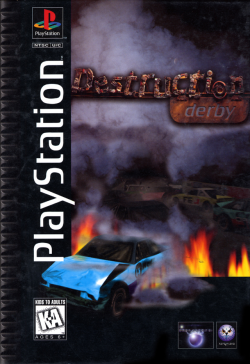
Destruction Derby is a 1995 vehicular combat racing video game developed by Reflections Interactive and published by Psygnosis for MS-DOS, PlayStation and Sega Saturn. Based on the sport of demolition derby, the game tasks the player with racing and destroying cars to score points. The developers implemented simulated physics to make the results of collisions easier to predict, and they kept the game's tracks small to increase the number of wrecks. Critics found Destruction Derby enjoyable and praised its graphics and car damage system, although the Saturn release received mixed reviews. The game started the Destruction Derby series, beginning with its 1996 sequel, Destruction Derby 2.

Need for Speed II is a 1997 racing video game released for PlayStation and Microsoft Windows. It is a part of the Need for Speed series and is the second installment, following The Need for Speed.

Need for Speed: High Stakes, released as Need for Speed: Road Challenge in Europe, is a 1999 racing video game developed by EA Canada and EA Seattle and published by Electronic Arts for the PlayStation and Microsoft Windows. It is the fourth game in the Need for Speed series and a follow-up to Need for Speed III: Hot Pursuit. The game features more realistic elements than its predecessors and introduced a damage system that allows cars to take damage when colliding with objects, affecting their appearance and performance. It also introduced a series of economy-based tournaments, awarding players with a cash prize that can be spent on repairing, purchasing, or upgrading cars for subsequent races. The game's Hot Pursuit mode, which was introduced in Hot Pursuit, was expanded with more options, allowing players to control police pursuits attempting to stop racers.

V-Rally is a racing video game developed by Infogrames Multimedia and released for the PlayStation console in 1997. The first game in the V-Rally series, it is based on the 1997 and 1998 World Rally Championship seasons, and features officially licensed cars and tracks inspired by real locations of rally events. Players drive rally cars through a series of stages spread over eight different locations, ranging from European countries like England, Spain or Sweden, to island countries such as Indonesia and New Zealand. As a simulation game, V-Rally places a strong emphasis on replicating the behavior physics of real cars and generally requires more practice than arcade-style racers.

Beetle Adventure Racing! is a racing game released for the Nintendo 64 in 1999. It was developed by Paradigm Entertainment and EA Canada, and published by Electronic Arts. Each vehicle in the game is a Volkswagen New Beetle, which was released the previous year. The gameplay involves racing other players on unlocked tracks, finding and destroying crates, and collecting colored ladybugs while battling other players. The single-player championship offers three circuits and a secret bonus circuit with new vehicles and tracks available upon completion.

MRC: Multi-Racing Championship is a racing video game developed by Genki and released for the Nintendo 64 in 1997. It was published in North America and Europe by Ocean and in Japan by Imagineer. The game is compatible with the Controller Pak and the Rumble Pak.
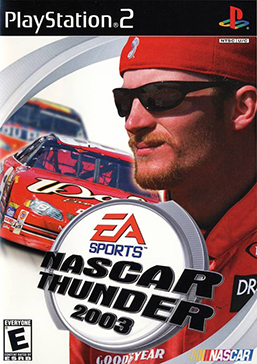
NASCAR Thunder 2003 is the sixth edition of the EA Sports' NASCAR racing simulator series. Developed by EA Tiburon and Budcat Creations and published by EA Sports. It was released for PlayStation, PlayStation 2, GameCube, and Xbox on September 18, 2002, and for Microsoft Windows on October 21. The product features Dale Earnhardt Jr. on the cover. It was the first time the NASCAR's Most Popular Driver Award recipient was featured on the cover, although he did not win the award for the first time until the following year. Dale Earnhardt appeared in the game as a driver as a result of entering his name as a Create-A-Car driver's name; he did not appear in the previous game due to his death. He appeared as a legend in subsequent games.

Monster Truck Madness is a racing video game developed by Terminal Reality and published by Microsoft. It was released in North America on September 9, 1996. The game has twelve monster trucks and tasks the player with beating computer opponents. Checkpoints, multiple hidden shortcuts, and interactable objects commonly appear in the tracks. In the garage, the player modifies the truck to account for terrain surfaces. Online multiplayer is accessed with a modem, a local area network (LAN), or TCP/IP.
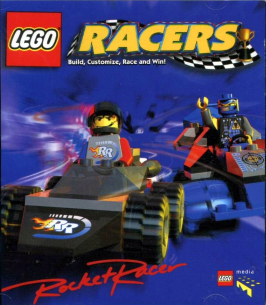
Lego Racers is a 1999 Lego-themed kart racing video game developed by High Voltage Software and published by Lego Media for Microsoft Windows, followed by console ports to Nintendo 64 and PlayStation. Set in the fictional "Legoland" universe, the single-player mode follows various minifigure characters competing in a racing competition created by a fictional racing champion called Rocket Racer.

TOCA: Touring Car Championship is a 3D racing video game licensed by series organisers TOCA, and developed and published by Codemasters for the PlayStation and Microsoft Windows platforms in 1997-1998. It was re-released by Codemasters for the Game Boy Color in 2000. It was the first entry in the eponymous series and was followed by TOCA 2 Touring Cars in 1998. The player takes control of a driver who races for one of the eight works teams that contested the 1997 British Touring Car Championship against fifteen AI competitors on one of the nine championship circuits. A championship mode is available for players with the objective of earning points to continue competing and unlocking new features.
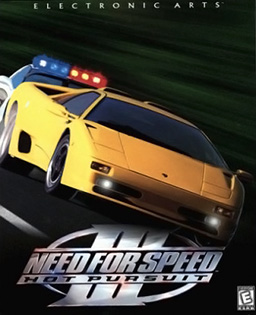
Need for Speed III: Hot Pursuit is a 1998 racing video game developed for PlayStation by EA Canada and Microsoft Windows by EA Seattle, and published by Electronic Arts. It is the third major installment in the Need for Speed franchise, incorporating police pursuits as a major part of gameplay. Hot Pursuit remains focused on racing using exotic sports cars, but features races that primarily take place in locations within North America, including varied settings and climates. Police AI is improved over the first game, utilizing several tactics to stop both the player and opponent. The PlayStation version was released on March 24, 1998, while the Windows version was released on October 12 the same year. The game received critical success, with praise for its graphics and customization options. It received a direct sequel in 2002 and a reboot in 2010.

South Park Rally is a kart-style racing video game released in early 2000 based on the American animated sitcom South Park published by Acclaim Entertainment and released for the PlayStation, Microsoft Windows, Nintendo 64, and Dreamcast. Gameplay follows the player in a competitive racing championship set in the fictional town of South Park. Players are given the options for multiplayer, arcade, or championship modes, but only the championship unlocks extra features. Competition begins in South Park's 1st Rally, a circuit race around four checkpoints in the downtown area of South Park. Races get gradually more diverse, with more locations, racers, and elements added as the game progresses.

Destruction Derby 64 is a vehicular combat racing video game developed by Looking Glass Studios and published by THQ, under license from Psygnosis. It is the third installment in the Destruction Derby series, released on 30 September 1999 in North America and 12 October 1999 in Europe for the Nintendo 64.
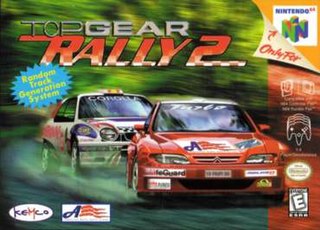
Top Gear Rally 2 is a racing video game developed by Saffire and released for the Nintendo 64 in 1999. It is a sequel to Top Gear Rally.

Colin McRae: Dirt 2 known outside Europe as Dirt 2 is a racing video game developed and published by Codemasters in 2009, first for the Nintendo DS, PlayStation 3, PlayStation Portable, Wii and Xbox 360, and then later for PC platforms. It is the sequel to Colin McRae: Dirt. Dirt 2 is the first game in the series since McRae's death in 2007 and the last to feature his name in the title. It is also the first and only game in the series to be available on a Nintendo home console and the last game in the series to be released on handhelds.

Top Gear Pocket, known in Europe as Top Gear Rally, is a racing video game developed by Kemco and released for the Game Boy Color handheld console in 1999. A sequel, Top Gear Pocket 2, was released in 2000.

Harley-Davidson: Race Across America is a racing game developed by Canopy Games and G2M Games, and published by WizardWorks in 1999. The game centers on racing Harley-Davidson motorcycles across different locales in the United States, with the ultimate goal being to reach the Sturgis Motorcycle Rally.
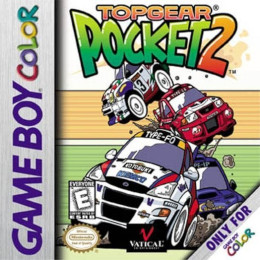
Top Gear Pocket 2, known in Europe as Top Gear Rally 2, is a racing video game developed by Kemco and released for the Game Boy Color handheld console, released on December 17, 1999 in Japan and in 2000 across other regions. It is a sequel to Top Gear Pocket.



















